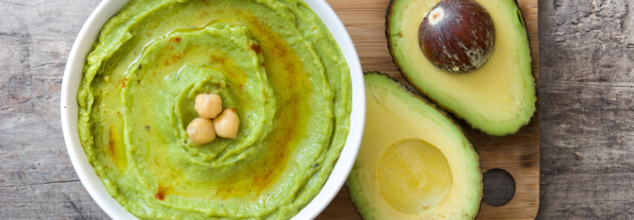- Health Conditions A-Z
- Health & Wellness
- Nutrition
- Fitness
- Health News
- Ayurveda
- Videos
- Medicine A-Z
- Parenting
Avocado Hummus May Be The Best Snack For Your Digestive Health

(Credit-Canva)
Finding light and healthy snacks can be a lifesaver for people, especially for people who are looking to lose weight. One of the biggest reasons why people fail to lose weight is because they are unable to fix their dietary habits. There is always this air of disappointment surrounding healthy food, that it can never be as good as a box of fries and a burger. But knowing how to make healthy, yet tasty food can be a great thing! To make your switch to healthy foods you have to ease into it, try small changes like changing your sandwich fillings, breakfast options, the dips you use to eat snacks with etc. One such lesser know healthy dips might help you not only lose weight but bring your digestive health back on track!
Avocado hummus is a delightful and nutritious twist on traditional hummus. It takes the familiar, earthy flavors of chickpeas and tahini and blends them with the creamy richness of avocado, creating a vibrant green dip that's as good for you as it tastes. Think of it as guacamole's healthier, more sophisticated cousin. It's a fantastic option for anyone looking for a snack that's low in carbohydrates, naturally low in cholesterol, and packed with fiber.
Whether you enjoy it with pita bread, raw vegetables, or even just a spoon, avocado hummus is a versatile and easy way to incorporate more wholesome foods into your diet. It's a great way to add healthy fats and fiber to your diet while enjoying a flavorful treat.
What's good about it?
Avocado hummus is a nutritional powerhouse, thanks to its combination of wholesome, plant-based ingredients. Chickpeas are a fantastic source of plant-based protein and fiber, providing sustained energy and promoting digestive health. Avocado adds healthy monounsaturated fats, which are beneficial for heart health, as well as a significant amount of fiber. Tahini, made from sesame seeds, is also a good source of healthy fats and minerals.
This combination of ingredients makes avocado hummus a great choice for those looking to boost their intake of fiber, healthy fats, and plant-based protein. It's also naturally low in cholesterol, making it a heart-healthy option. The high fiber content contributes to feelings of fullness, which can be helpful for weight management. Plus, it's a delicious way to get essential nutrients.
Fiber plays a crucial role in maintaining good health, and avocado hummus is an excellent source of it. Soluble fiber, the type found in chickpeas and avocado, helps lower "bad" LDL cholesterol levels, reducing the risk of heart disease. Fiber also promotes healthy digestion by adding bulk to stool and preventing constipation. It helps regulate blood sugar levels, preventing spikes and crashes, which is particularly important for people with diabetes or insulin resistance.
Avocado hummus is a champion for digestive health, thanks to its high fiber content. Fiber adds bulk to stool, making it easier to pass through the digestive tract and preventing constipation. Both chickpeas and avocado are excellent sources of this essential nutrient. Chickpeas have been known for their potential laxative effect, gently encouraging bowel movements.
How does it help with digestion?
Avocado also contributes to regularity naturally. Beyond just promoting regularity, the fiber in avocado hummus also acts as a prebiotic, feeding the beneficial bacteria that live in your gut. A healthy gut microbiome is essential for digestion, nutrient absorption, and overall well-being. Furthermore, the healthy fats in avocado and olive oil can help lubricate the digestive tract, further promoting smooth and comfortable digestion.
Avocado hummus is a delicious, versatile, and incredibly healthy snack. It's packed with fiber, which is great for your heart, digestion, and overall health. It's also a good source of healthy fats and plant-based protein. It's easy to make at home with just a few simple ingredients, and it's a great way to add more nutrient-dense foods to your diet. Whether you're looking for a healthy dip, a satisfying snack, or a flavorful addition to a meal, avocado hummus is a winner. It's a simple and delicious way to support your well-being.
Vitamin B12 Deficiency Is Common In Vegetarians, AIIMS Doctor Explains Why

Credits: Canva
One of the challenges neurologists are seeing today is the steady rise in patients who show neurological problems tied to low vitamin B12 levels, especially among people who follow a strict vegetarian diet.
Recent findings from several PubMed studies, along with insights from practicing neurologists such as Dr Priyanka Sehrawat, who trained at the All India Institute of Medical Sciences (AIIMS), Delhi, indicate that people who follow a strict vegetarian diet face a much higher risk of developing vitamin B12 deficiency.
Dr Sehrawat explains that plants do not make vitamin B12 because they have no biological need for it, so a purely plant-based diet often falls short. Research also shows that this deficiency affects vegetarians across all age groups, including children, teenagers, adults and older individuals.
Why Vitamin B12 Matters
Vitamin B12 plays several key roles in keeping the body functioning well. It helps the body form healthy red blood cells, which maintain strong haemoglobin levels. It is involved in the repair and formation of DNA, the genetic framework that guides every cell. Just as importantly, it helps build and maintain the myelin coating around nerves, which allows signals to travel smoothly throughout the nervous system.
In a recent Instagram video, Dr Sehrawat highlighted why strict vegetarians rank among the most susceptible. She reiterated that plants cannot produce vitamin B12 at all. As a result, those who rely only on plant foods may not receive enough of this essential nutrient, and over time the body’s reserves begin to decline.
Why Plant-Based Diets Fall Short in Vitamin B12?
The doctor noted that vegan diets are built almost entirely on plant-based foods, which do not naturally contain enough vitamin B12. This nutrient is produced by bacteria that live in animal tissues and certain fermented foods. Although some fortified items exist, they often fall short of daily needs, especially for people with faster metabolisms or digestive problems that affect absorption.
Vitamin B12: Symptoms you Should Watch Out For
Persistent tiredness and weakness
When B12 levels drop, the body struggles to produce enough red blood cells. Reduced oxygen supply to tissues leads to constant fatigue, even after good rest, and a general decline in stamina.
Numbness, tingling or nerve sensitivity
Because B12 supports the maintenance of the myelin sheath, a deficiency may cause unusual sensations, such as tingling, numbness or heightened nerve sensitivity, especially in the hands and feet.
Memory lapses, mood swings or mental fog
Low B12 levels can affect concentration and memory and may contribute to mood changes or a sense of mental dullness.
Pale skin, shortness of breath, slow healing
Anaemia caused by inadequate red blood-cell production may appear as paler-than-usual skin, difficulty catching your breath during activity, or wounds healing more slowly than normal.
Tips On How Vegetarians Can Stay Safe
To prevent this hidden deficiency, vegetarians may consider the following steps:
• Choose fortified items, such as cereals or plant-based milk with added B12
• Add dairy or eggs, if compatible with their dietary preferences
• Use supplements or oral B12 tablets when food sources are limited
• Go for routine blood tests to monitor B12 levels, particularly if symptoms begin to show
Choosing a vegetarian lifestyle can be meaningful and fulfilling, but good nutrition requires attention. Dr Sehrawat’s reminder makes it clear that although plant-based diets have many benefits, they must be paired with reliable B12 sources to prevent a shortage that could affect long-term health.
Vitamin B12 Deficiency: Diagnosis, Symptoms and Treatment Options
Doctors are now seeing more individuals with low B12 levels who come in with unexplained nerve pain, cognitive decline or constant fatigue. The deficiency tends to progress slowly, which means many symptoms only appear after nerve damage has already started.
The doctor added that a simple blood test can detect the deficiency early enough to avoid long-term damage. Since vitamin B12 deficiency is one of the most reversible neurological conditions, timely supplements taken by mouth or through injections can restore levels and protect nerve function. Recovery may take longer if the deficiency is already severe.
Colostrum Supplements: Hype Or Helpful? What Doctors Want You To Know

Credits: Canva
On social media, many influencers mix colostrum powder into smoothies and coffees. Podcast ads promote it with big promises such as stronger immunity, better digestion, weight management, and quicker recovery after exercise. A spokesperson for GNC said in an email that interest in colostrum has surged over the past year.
In the company’s “Anti Trend Report,” colostrum was listed as one of the year’s standout supplement trends. Often nicknamed “liquid gold” for its warm golden colour or described as the body’s “starter kit” for newborns, colostrum plays a vital role in early development. The question many adults now ask is whether colostrum supplements are actually good for them.
What Is Colostrum?
Colostrum is the earliest form of milk produced during pregnancy. It develops in the mammary glands and supports a baby’s first line of defence against illness. If you choose to breastfeed, this is the first milk your baby receives. If breastfeeding is not possible or the baby has trouble latching, colostrum can be expressed by hand. It is rich in protein, vitamins, minerals, and antibodies that help build a newborn’s immunity. Cleveland Clinic notes that its deep golden tone and concentrated benefits have earned it the name “liquid gold.”
What Is Colostrum Made Of?
Colostrum contains a high level of protein with very little fat or sugar. It also carries white blood cells that create antibodies. These antibodies help protect a newborn from infections. Even in small amounts, colostrum is dense with nutrients, so a newborn’s stomach needs only a little to gain its benefits.
What Kind of Nutrients Are in Colostrum?
Colostrum offers a wide range of protective nutrients for a newborn. These include:
- Immunoglobulin A, which is an antibody.
- Lactoferrin, a protein that helps guard against infections.
- Leukocytes, which are white blood cells.
- Epidermal growth factor, a protein that encourages cell growth.
Are Colostrum Supplements Safe to Use?
Most people can take colostrum supplements without trouble, though they are not right for everyone. There are possible concerns, including allergic reactions in people who are sensitive to dairy, the chance of interfering with immune responses in those with weakened immunity, and digestive issues such as nausea or bloating when taken in larger amounts. MD Anderson Cancer Center advises speaking with a healthcare professional before using colostrum, especially if you have existing medical conditions or are pregnant or breastfeeding.
Who Should Be Cautious?
People with milk allergies: Because colostrum comes from dairy, it can cause allergic reactions and should be avoided.
Immunocompromised individuals: Those with weakened immune systems should discuss it with a doctor, as the immune-active components in colostrum may not be suitable for them.
Pregnant or breastfeeding women: These groups should only use colostrum supplements if a doctor recommends it.
Individuals with dairy intolerance: Anyone who reacts to milk or other dairy products should avoid colostrum as well.
The Presidential Diet: How Is Vladimir Putin So Fit At 73?

Credits: AP, President of Russia
Russian President Vladimir Putin is in India for a two-day trip. His visit in India is not just important for the summit the two countries are going to hold, but it has also sparked curiosity among many around his fitness regime, especially at the age of 73.
As per reports, his routine is based more on consistency than intensity. Putin is known for his discipline and is known for the variety of sports and workouts he indulges in. He is also a long time judo practitioner, and also enjoys horse riding, skiing, and ice hockey.
As much as he is in love with sports, he also ensures to keep up with his diet, which, according to reports, is high in protein and low in sugar. This supports muscle recovery and energy. His diet is often referenced in Russian state media and remains one of the few recurring details about his health routine.
What Is Putin's Diet Like?
Russia Beyond reports that Putin keeps his physique in shape by sticking to a clean, fairly simple diet, even though he does enjoy the occasional treat. His mornings are usually quite routine: a bowl of porridge, some tvorog, a Russian-style cottage cheese with a bit of honey, and a couple of raw quail eggs, which he reportedly drinks straight.
Putin is also known to enjoy a drink made with beetroot and horseradish juice, a mix loaded with vitamins and iron.
He is not someone who craves sweets, so apart from honey, the only dessert he occasionally enjoys is ice cream. In interviews with Russian journalists, he has mentioned that he likes rice and buckwheat but is not a fan of oats. Vegetables, however, are a constant in his meals. He likes having a simple salad with tomatoes and cucumbers, and when choosing between fish and meat, he usually prefers fish, though he enjoys lamb as well.
His daily routine often dictates his eating habits. In the afternoon, he usually has some fruit or a glass of kefir and tends to skip dinner altogether. When he travels, he does try local dishes but keeps the portions small.
“I don’t have much time for food,” he once said in an interview. "I like vegetables: Tomatoes, cucumbers, salad. In the morning - porridge, cottage cheese, honey. If there’s a choice between meat and fish - I prefer fish, I also like lamb,” he said.
Is Putin Eating A Balanced Diet?
From a nutritional perspective, Putin’s choice of a high-protein, no-frills breakfast is exactly what many experts recommend. Meals rich in protein keep you full for longer, help curb cravings, prevent blood sugar spikes, and support steady energy levels through the day.
Research shows that protein-heavy, low-sugar breakfasts increase fullness hormones like PYY and GLP-1 far more than carb-loaded morning meals, making appetite control easier and more effective.
His habit of opting for a light snack in the evening and skipping dinner also aligns with studies that link early, low-calorie eating patterns to better weight management and improved cognitive health.
Combined with cottage cheese, eggs, and a disciplined fitness routine, Putin’s daily habits help him maintain a muscular build and stable energy levels even with a demanding schedule.
© 2024 Bennett, Coleman & Company Limited

